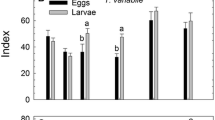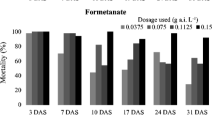Abstract
In order to control the spread of the huanglongbing (HLB) disease in citrus plants, one of the main approaches is management of its vector, the Asian citrus psyllid, Diaphorina citri Kuwayama. The intensive use of chemicals to control the psyllid has caused concern due to the damage to the environment and human health, and biological control has been a more sustainable and environmentally safe strategy. For D. citri, the parasitoid wasp Tamarixia radiata Waterston has been used successfully in the state of São Paulo, Brazil, reducing populations of D. citri nymphs by up 80% in some municipalities. Mass rearing of wasps is required to provide efficient control, which implies that quality control is required, especially in storage and transportation. In most cases, the insects are not used on the same day of emergence, which makes it necessary to develop strategies to delay development without negatively affecting the wasps. Here, we evaluated the survival of T. radiata adults over eight different exposure times (2, 4, 6, 8, 10, 12, 14, and 16 days) in three different temperatures (7, 9, and 11°C). After these periods, they were transferred to climate chambers at 25°C and their survival curves over 30 days were analyzed. We concluded that adults can be maintained at 9°C for up to 6 days without significant damage to their survival during and after the exposure period, functioning well for D. citri IPM implementation.



Similar content being viewed by others
References
Barratt BIP, Moran VC, Bigler F, van Lenteren JC (2018) The status of biological control and recommendations for improving uptake for the future. BioControl 63:155–167
Blaustein RA, Lorca GL, Teplitski M (2018) Challenges for managing Candidatus Liberibacter spp. (huanglongbing disease pathogen): current control measures and future directions. Phytopathology 108:424–435
Bové JM (2006) Huanglongbing: a destructive, newly-emerging, century-old disease of Citrus. J Plant Pathol 88:7–37
Canales E, Coll Y, Hernández I, Portieles R, García MR, López Y, Aranguren M, Alonso E, Delgado R, Luis M, Batista L, Paredes C, Rodríguez M, Pujol M, Ochagavia ME, Falcón V, Terauchi R, Matsumura H, Ayra-Pardo C, Llauger R, Pérez MDC, Núñez M, Borrusch MS, Walton JD, Silva Y, Pimentel E, Borroto C, Borrás-Hidalgo O (2016) “Candidatus Liberibacter asiaticus”, causal agent of citrus huanglongbing, is reduced by treatment with brassinosteroids. PLoS One 11(1):e0146223
Chen X, Stansly PA (2014) Biology of Tamarixia radiata (Hymenoptera: Eulophidae), parasitoid of the citrus greening disease vector Diaphorina citri (Hemiptera: Psylloidea): a mini review. Fla Entomol 97:1404–1413
Chen W-L, Leopold RA, Boetel MA (2008) Cold storage of adult Gonatocerus ashmeadi (Hymenoptera: Mymaridae) and effects on maternal and progeny fitness. J Econ Entomol 101:1760–1770
Chien CC, Chu YI, Ku HC (1994) Oosorption and oviposition-regulating capability of the eulophid wasp, Tamarixia radiata, and its internal reproductive organs. Plant Prot Bull 36:19–30
Colinet H, Boivin G (2011) Insect parasitoids cold storage: a comprehensive review of factors of variability and consequences. Biol Control 58:83–95
Colinet H, Hance T, Vernon P (2006) Water relations, fat reserves, survival, and longevity of a cold-exposed parasitic wasp Aphidius colemani (Hymenoptera: Aphidiinae). Environ Entomol 35:228–236
Colinet H, Sinclair BJ, Vernon P, Renault D (2015) Insects in fluctuating thermal environments. Annu Rev Entomol 60:123–140
CropLife Brasil (2020) Brasil se destaca no mercado de controle biológico. https://croplifebrasil.org/noticias/brasil-se-destaca-no-mercado-de-controle-biologico/. Accessed 16 Jul 2020
Diniz A (2013) Otimização da criação de Diaphorina citri Kuwayama, 1908 (Hemiptera: Liviidae) e de Tamarixia radiata (Waterston, 1922) (Hymenoptera: Eulophidae), visando a produção em larga escala do parasitoide e avaliação do seu estabelecimento em campo. University of São Paulo, SP, Dissertation, 128 p
Diniz AJF, Garcia AG, Alves GR, Reigada C, Vieira JM, Parra JRP (2020) The enemy is outside: releasing the parasitoid Tamarixia radiata (Hymenoptera: Eulophidae) in external sources of HLB inocula to control the Asian Citrus Psyllid Diaphorina citri (Hemiptera: Liviidae). Neotrop Entomol 49:250–257
García Y, Ramos YP, Sotelo PA, Kondo T (2016) Biology of Diaphorina citri (Hemiptera: Liviidae) under glass house conditions in Palmira, Colombia. Rev Colomb Entomol 42:36–42
Gardner CL, Pagliai FA, Pan L, Bojilova L, Torino MI, Lorca GL, Gonzalez CF (2016) Drug repurposing: Tolfenamic acid inactivates PrbP, a transcriptional accessory protein in Liberibacter asiaticus. Front Microbiol 7:1–16
Ghosh E, Ballal CR (2018) Short-term storage of the egg parasitoids, Trichogramma and Trichogrammatoidea. Egypt J Biol Pest Control 28(34). https://doi.org/10.1186/s41938-018-0039-y
Gomez-Torres ML, Nava DE, Parra JRP (2012) Life table of Tamarixia radiata (Hymenoptera: Eulophidae) on Diaphorina citri (Hemiptera: Psyllidae) at different temperatures. J Econ Entomol 105:338–343
Gomez-Torres ML, Nava DE, Parra JRP (2014) Thermal hygrometric requirements for the rearing and release of Tamarixia radiata (Waterston) (Hymenoptera, Eulophidae). Rev Bras Entomol 58:291–295
Gottwald TR (2010) Current epidemiological understanding of citrus Huanglongbing. Annu Rev Phytopathol 48:119–139
Grafton-Cardwell EE, Stelinski LL, Stansly PA (2013) Biology and management of Asian Citrus Psyllid, vector of the Huanglongbing pathogens. Annu Rev Entomol 58:413–432
Greenberg S, Gorban V, Liu T (2015) Mass propagation of Trichogramma spp. on factitious hosts: current situation and approaches to deal with in vivo rearing problems: production of factitious hosts for Trichogramma and equipment needs. In: Vinson B, Greenberg S, Liu T, Rao A, Volosciuk L (eds) Biological control of pests using Trichogramma: current status and perspectives. Northwest A&F University Press, China, pp 81–131
Hall DG, Klein EM (2014) Short-term storage of adult Tamarixia radiata (Hymenoptera: Eulophidae) prior to field releases for biological control of Asian Citrus Psyllid. Fla Entomol 97:298–300
Hoddle MS (2012) Has the Asian Citrus Psyllid parasitoid. Tamarixia radiata, established in California? http://cisr.ucr.edu/blog/asian-citrus-psyllid-2/has-the-asian-citrus-psyllid-parasitoid-tamarixia-radiata-established-in-california/. Accessed 16 Jul 2020
Inoue H, Ohnishi J, Ito T, Tomimura K, Miyata S, Iwanami T, Ashihara W (2009) Enhanced proliferation and efficient transmission of Candidatus Liberibacter asiaticus by adult Diaphorina citri after acquisition feeding in the nymphal stage. Ann Appl Biol 155:29–36
Jalali SK, Singh SP (1992) Differential response of four Trichogramma species to low temperatures for short term storage. Entomophaga 37:159–165
Koštál V, Yanagimoto M, Bastl J (2006) Chilling-injury and disturbance of ion homeostasis in the coxal muscle of the tropical cockroach (Nauphoeta cinerea). Comp Biochem Physiol B: Biochem Mol Biol 143:171–179
Leopold, R. A. (1998). Cold storage of insects for integrated pest management. In G. J. Hallman & D. L. Denlinger (eds) Temperature sensitivity in insects and application in integrated Pest management. Westview Press, Boulder, pp 235–267
Leopold R (2007) Colony maintenance and mass-rearing: using cold storage technology for extending the shelf-life of insects. In: Vreysen MJB, Robinson AS, Hendricks J (eds) Area-wide control of insect pests: from research to field implementation. Springer, Dordrecht, pp 149–162
Mohamed HO, El-Heneidy AH (2020) Effect of cold storage temperature on quality of the parasitoid, Trichogrammatoidea bactrae Nagaraja (Hymenoptera: Trichogrammatidae). Egypt J Biol Pest Control 30:87. https://doi.org/10.1186/s41938-020-00288-z
Morris J, Coulson G, Meyer M, Fuller R (1983) Cold shock-a widespread cellular re- action. Cryo-Letters 4:179–192
Pandey R, Johnson M (2005) Effects of cool storage on Anagyrus ananatis Gahan (Hymenoptera: Encyrtidae). Biol Control 35:9–16
Pelz-Stelinski KS, Brlansky RH, Ebert TA, Rogers ME (2010) Transmission parameters for Candidatus Liberibacter asiaticus by Asian Citrus Psyllid (Hemiptera: Psyllidae). J Econom Entomol 103:1531–1541
Rundle BJ, Thomson LJ, Hoffmann AA (2004) Effects of cold storage on field and laboratory performance of Trichogramma carverae (Hymenoptera: Trichogrammatidae) and the response of three Trichogramma spp. (T. carverae, T. nr. brassicae, and T. funiculatum) to cold. J Econom Entomol 97:213–221
Siam A, Zohdy NZM, ELHafez AMA, Moursy LE, Sherif HAEL (2019) Effect of different cold storage periods of rearing host eggs on the performance of the parasitoid Trichogramma evanescens (Westwood) (Hymenoptera: Trichogrammatidae). Egypt J Biol Pest Control 29(34). https://doi.org/10.1186/s41938-019-0139-3
Silva GV, Bueno AF, Favetti BM, Neves PMOJ (2019) Use of low temperature storage to preserve host and parasitoid to improve the rearing of Telenomus podisi (Hymenoptera: Platygastridae) on Euschistus heros (Hemiptera: Pentatomidae) eggs. Neotrop Entomol 48:126–235
Silveira Neto S, Nakano O, Barbin D, Villa Nova N (1976) Manual de Ecologia de Insetos. Livroceres, Piracicaba, p 419
Sømme L (1995) Invertebrates in hot and cold arid environments. Springer, Berlin Heidelberg, Berlin, Heidelberg, p 275
Teixeira C, Saillard C, Eveillard S, Ayres AJ, Danet JL, Ina P, Bove J (2005) “Candidatus Liberibacter americanus”, associated with citrus huanglongbing (greening disease) in São Paulo State. Brazil Int J Syst Evol Microbiol 55:1857–1862
van Lenteren JC, Tommasini MG (1999) Mass production, storage, shipment and quality control of natural enemies. In: Albajes R, Lodovica Gullino M, van Lenteren JC, Elad Y (eds) Integrated pest and disease management in greenhouse crops. Springer Netherlands, Dordrecht, pp 276–294
Venkatesan T, Singh S, Jalal S (2000) Effect of cold storage on cocoons of Goniozus nephantidis Muesebeck (Hymenoptera: Bethylidae) stored for varying periods at different temperature regimes. J Entomol Res 24:43–47
Zhang LH, Lu ZT, Guo CF, Le Shen Z, Wang ZQ, Sang W, Qiu BL (2020) Effects of cold storage on the fitness of Tamarixia radiata, a dominant parasitoid of Asian citrus psyllid Diaphorina citri. Crop Prot 128:104988. https://doi.org/10.1016/j.cropro.2019.104988
Acknowledgments
We extend our thanks to Janet W. Reid (JWR Associates) for the English revision.
Funding
LAB holds a fellowship awarded by Fundecitrus (Project 837). AGG holds a fellowship awarded by FAPESP (2019/26071-8). The authors would like to thank SPARCBio (São Paulo Advanced Research Center for Biological Control) (FAPESP-Koppert, 2018/02317-5).
Author information
Authors and Affiliations
Contributions
LAB conceived the project, conducted the experiments and the paper was primarily based on her undergraduate thesis. AJFD and JRPP supervised the experiments. AGG performed the statistical analysis. All authors participated in discussing the results and writing the manuscript.
Corresponding author
Additional information
Edited by Guilherme Duarte Rossi
Publisher’s Note
Springer Nature remains neutral with regard to jurisdictional claims in published maps and institutional affiliations.
Rights and permissions
About this article
Cite this article
Bertanha, L.A., Diniz, A.J.F., Garcia, A.G. et al. Determining the Minimum Temperature for Storage of Tamarixia radiata (Hymenoptera: Eulophidae) Adults for Biological Control of Asian Citrus Psyllid. Neotrop Entomol 50, 114–120 (2021). https://doi.org/10.1007/s13744-020-00832-4
Received:
Accepted:
Published:
Issue Date:
DOI: https://doi.org/10.1007/s13744-020-00832-4




